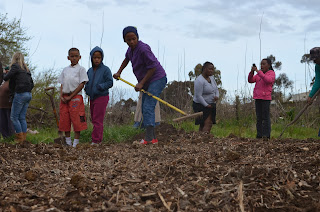 |
| Picturesque Greyton |
Greyton and its surrounding area is a picturesque town surrounded by often snow capped mountains, natural plains of the native bush - fynbos - and fields of crops and animals. It is a place that oozes serenity and whispers in your ear:
"Slow down, relax, just breathe in the fresh mountain air and sigh contentedly, relish in the environment."
Despite being change of pace from the bustling city of Sydney, the chaos of Bali traffic and the high rising jungle of apartment blocks in Singapore, Greyton is a town that is also changing and healing, becoming more self-sufficient in an environmental sense and knitting itself tighter as a community. The town and neighbouring Heuwelkroon and Genadendal have quite a history, especially with the near 40 years of apartheid in South Africa between 1948-1994. And despite it being two decades next year since apartheid was abolished, the economic and social disparity and disconnect between the coloured and white population is more than evident when you lift the proverbial rug.
My first impression of the adjacent township of Heuwelkroon was at a memorial gathering for a young boy who had passed away from cancer the year before. I walked around the compacted dirt roads with my friend and Greyton Transition Town* member Candice, as the only White and Asian people in the township. My first impressions were that of sadness, seeing that people were living in such small houses cramped in like sardines in a can and in such poor living conditions compared to the houses that I had seen in the town of Greyton and the barn that I was staying in.
However, as the children ran up to us with smiles on their faces I remembered how so many people in poorer parts of the world without the confines of society could find happiness and beauty in the smallest things. I remembered that these people are often many of the most genuine and pure people that I had the honour of meeting, and I was glad for their attitude.
Sure enough, many inhabitants of Heuwelkroon are genuine and pure people, always helping each other out and helping us in our work too, most of all, the sentiment that I felt was that they are accepting and kind people, always offering to share despite having little.
With the new generation of people, there is a growing respect between cultures and a bigger willingness to integrate together into a larger community unmarred by the scars of apartheid nineteen years ago, however, the invisible walls between the two cultures in Greyton and Heuwelkroon are not that easy to break down, nor are the evident divides between the Rastafarian and Christian communities in Heuwelkroon.
There is a plethora of issues that need to be addressed, especially that of alcohol and drug abuse, entrepreneurship and unemployment, and the need for life education and empowerment for many youths who have little aspirations.
I am not a hero who can fix any of these issues in the 2 months that I am here, but I have the utmost confidence that in the years to come, brick by brick, the invisible walls that divide the social standing between the residents of Greyton and Heuwelkroon will fall, organically, as seeds of change sprout and grow.
There are projects in place and people who are passionate about the future of their town, there are capable young people who are filled with ideas to bring the community together. A young girl named Nokwasi had the idea of a community garden, which we are making a reality: A communal space for people to grow food together and sustain themselves and their families. A return to the idea of self-sustainability and food security.
While I am here, I am working with primary and high schools to encourage environmental awareness and to develop a relationship with them, advocating them to have bigger aspirations and to become tall poppies, supporting each other to be better and better. My time is limited and short, but I hope to plant an idea that will grow and flourish long after I leave.
What am I? I am but a plank in one of the bridges that are being built towards a sustainable and integrated future in Greyton.
*Greyton Transition Town is the organization that I am working with for the 2 months that I am in South Africa see www.greytontransition.co.za




